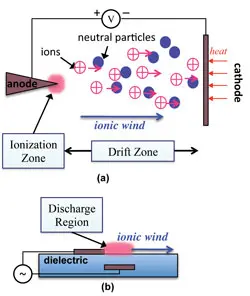Rotary fans have been used to cool electronic devices using forced convection applications to achieve the required heat transfer dissipation. In recent years, there has been an increasing trend to miniaturize the size and maximize the efficiency of the electronic devices which, in turn, increases heat generation. The use of rotary fan cooling conflicts with these new trends due to size, noise, power consumption and cooling efficiency limitations. As a result, there has been an increase in efforts trying to find alternative ways of cooling, such as air ionization techniques, which are still at the research stage. This technique shows a promising and effective way of cooling while supporting both miniaturization and increased device performance.
This blog will review and investigate ionized cooling technology studies. It will highlight the effect of the air gap distance and the effect of the number of the emitters and receivers on heat transfer performance. Furthermore, the relation between the applied electrical conditions and the resulting characteristics of flow velocity, boundary layer, and heat transfer will be discussed. In addition, the performance of this technique will be compared to that of the traditional rotary fan.
The air ionization technique has been studied and developed over decades. The concept of air ionization was discovered by Hauksbee in 1709 (Owsenek and Seyed-Yagoobi, 1994). Robinson (1961:366) defines air ionization as “the movement of gas induced by the repulsion of air ions from the neighborhood of a high voltage discharge electrode”. Darabi and Rhodes (2006) describe the air ionization as a complex phenomenon which does not have accurate theoretical equations to be modeled.
The principal mechanism of the ionic wind technique is to use two electrodes and apply a high voltage to the sharp electrode. Accordingly, the air molecules near this electrode will be ionized and transfer their energy to the natural air molecules, which generates an air flow (Moore, 2009). Many researchers mention the principles of air ionization mechanism on the base of positive polarity technique which is the use of a cathode as an emitter electrode and an anode as a receiver electrode, so the positively ionized particles will move from the high voltage positive side towards the low voltage negative side (Jewell-Larsen et al., 2008a; Jewell-Larsen et al., 2008b; Lehman, 2008; Jewell-Larsen et al., 2009; Wan, 2009; Rigit and Chiong, 2011).
Figure 1. (a) Schematic of positive mode point-to-plane corona discharge-generated ionic wind. (b) Schematic of dielectric barrier discharge ionic wind, also called a plasma actuator. (Source: Electronics Cooling. Rakshit Tirumala, Technical Brief Volume 18)
On the other hand, some researchers mention the principle of ionization mechanism based on the negative polarity technique which is the use of an anode as an emitter electrode and the cathode as a receiver electrode at which the negatively ionized particles move from the high voltage anode side to the low voltage cathode side (Darabi and Rhodes, 2006; Chua et al., 2008; Pekker and Young, 2011; Ongkodjojo Ong, 2013). However, both of these techniques are correct and supply the required air flow velocity, but Jewell-Larsen et al., (2006) argue that the positive polarity technique could supply a higher air velocity.
The advantages of air cooling ionization include decreased power consumption, the increase of cooling performance and size reduction with compare to the traditional ways (Jewell-Larsen et al., 2006; Hsu et al., 2007). Moreover, this technique contains many distinguishing features such as silent operation, high design flexibility, high performance, no moving parts and, finally, a wide range of velocity control (Jewell-Larsen et al., 2009; Moore, 2009).
Despite the valuable advantages that electronics could have from the use of air ionization technique, there are some drawbacks which can restrict the development of this technique. These disadvantages are the need to apply high voltage in the emitter electrode to ionize the surrounded air, the degradation and oxidation of the electrode, and the effect of the accumulative dust on the electrodes which could restrict the ionization process (Moore, 2009). These disadvantages could be overcome using an alternative solution, such as changing the electrode material and control of the system sensitivity to dust accumulation.
The air cooling ionization process is achieved by air flow which is in contact with the hot surfaces of the chip of the electronic devices. This air flow is induced by the ionization process. However, the air cooling ionization criteria can be modeled by a combination of three different fundamental equations which are: electrostatic, fluid flow and heat transfer equations (Owsenek and Seyed-Yagoobi, 1994).
Heat transfer and the boundary layer are found to be highly enhanced by the use of air ionization. Go et al. (2007) reported that there was an improvement in the boundary layers, heat transfer coefficient, and velocity distribution when they used an air ionization system instead of the rotary fan. Go et al. (2008) studied the generated ionized air flow between a steel-wire and a copper-tape. They explain that there was a 200% enhancement in heat transfer when they replaced the stock rotary fan by the air cooling ionization system. The enhancement in the heat transfer coefficient and the boundary layers were found to be in upstream and downstream of the electrode but the enhancement in downstream was larger than in upstream. Balagopal (2011) found that the heat transfer and the boundary layers are affected by many design features such as the applied input power conditions, the effect of air gap distance and the number of electrodes.
The cooling performance of the air cooling ionization technique is highly affected by the applied power input (voltage and current). Yang et al. (2003) found an exponential relationship between the applied voltage and current in addition to a linear relationship between the applied voltage and the resulting flow velocity. Jewell-Larsen et al. (2008a) found a linear relationship between the applied input power and the ionized air flow velocity, which is linearly proportional with the heat transfer coefficient. Hsu et al. (2009) argued that there is a linear relationship between the heat transfer coefficient and the applied voltage for any gap distance, while the ionized air flow velocity is found to be directly proportional with the square root of the applied current. Pekker and Young (2011) pointed out that the maximum current could be achieved for any ionic system, and the efficiency of the system is in an inverse proportion with the applied current.
The operational performance of the air cooling ionization system is significantly affected by the air gap distance, which is the distance between the emitter and receiver electrodes. Darabi and Rhodes (2006) found that as the air gap distance increases the air pressure decreases while the flow rate, which is in direct proportion with the heat transfer, increases to a certain limit then decreases. Wan (2009) concluded that there is an optimal gap distance for any air ionization system at which the optimal characteristics of cooling and power consumption can be obtained. Schlitz and Singhal (2008) found that the required voltage to ionize the air is decreased when the gap distance decreases and discovered that the voltage decrease plays a role in the reduction of the required applied power. Hsu et al. (2009) found that for each gap distance there is an operational voltage which decreases when the gap distance decreases. These results support what Schlitz and Singhal found in 2008. The results of these studies prove that the air gap distance between the emitter and the receiver electrodes is a critical issue which should be chosen properly according to the air ionization system characteristics.
Little information has been found on the effect of the number of emitter and receiver electrodes on the efficiency of the air cooling ionization system. Islamov (2013) found that the ionized air flow velocity slightly depend on the number of wires. Ongkodjojo Ong (2013) found a novel method that uses one emitter electrode with two parallel grid plates as receiver electrodes; this method proved that this structural design enhances the heat transfer and the general performance of the air ionization system.
Conclusion
In conclusion, this investigation of the air cooling ionization technique in electronic devices has illustrated the principles and the different design features that affect the performance of the technique. This method of cooling by air ionization has been demonstrated as a practical way of cooling which could match up well with new development trends in electronic devices. The air gap distance, the number of electrodes, and the effect of the applied input conditions (voltage and current) have been found to be effective features that influence the performance of the system.
A final note: The investigation was limited by the lack of information and studies on the effect of the electrode material type on the longevity and the operational performance of the system.
References
Balagopal, S.M. 2011. Counter-Flow Ionic Wind for Heat Transfer Enhancement. thesis, University of Notre Dame.
Chua, B. et al. 2008. Design, fabrication, and testing of a microfabricated corona ionizer. Microelectromechanical Systems, Journal of. 17(1), pp.115-123.
Darabi, J. and Rhodes, C. 2006. CFD modeling of an ion-drag micropump. Sensors and Actuators A: Physical. 127(1), pp.94-103.
Go, D.B. et al. 2007. Ionic winds for locally enhanced cooling. Journal of Applied Physics. 102(5), p053302.
Go, D.B. et al. 2008. Enhancement of external forced convection by ionic wind. International Journal of Heat and Mass Transfer. 51(25), pp.6047-6053.
Hsu, C.-P. et al. 2009. Heat-transfer-enhancement measurement for microfabricated electrostatic fluid accelerators. Microelectromechanical Systems, Journal of. 18(1), pp.111-118.
Hsu, C. et al. 2007. Characterization of Microfabricated Cantilever-to-Plane Electrostatic Fluid Accelerators for Cooling in Electronics. In: ASME 2007 International Mechanical Engineering Congress and Exposition: American Society of Mechanical Engineers, pp.121-127.
Islamov, R.S. 2013. An analytical model of the ionic wind in a regular ultracorona. Journal of Physics D: Applied Physics. 46(37), p375204.
Jewell-Larsen, N. et al. 2008a. CFD analysis of electrostatic fluid accelerators for forced convection cooling. Dielectrics and Electrical Insulation, IEEE Transactions on. 15(6), pp.1745-1753.
Jewell-Larsen, N. et al. 2009. Electrohydrodynamic (EHD) cooled laptop. In: Semiconductor Thermal Measurement and Management Symposium, 2009. SEMI-THERM 2009. 25th Annual IEEE: IEEE, pp.261-266.
Jewell-Larsen, N. et al. 2006. Design and optimization of electrostatic fluid accelerators. Dielectrics and Electrical Insulation, IEEE Transactions on. 13(1), pp.191-203.
Jewell-Larsen, N.E. 2004. Optimization and miniaturization of electrostatic air pumps for thermal management. thesis, University of Washington.
Jewell-Larsen, N.E. et al. 2008b. Modeling of corona-induced electrohydrodynamic flow with COMSOL multiphysics. In: Proc. ESA Annual Meeting on Electrostatics, Paper E.
Lehman, J. 2008. Heat Removal of Microelectronics through Plasma Technology.
Moore, C. 2009. Will Ionic Wind Cool MacBooks of the Future? [Online]. Available from: http://gigaom.com/2009/06/15/will-ionic-wind-cool-macbooks-of-the-future/.
Ongkodjojo Ong, A. 2013. Electrohydrodynamic Microfabricated Ionic Wind Pumps for Electronics Cooling Applications. thesis, Case Western Reserve University.
Owsenek, B. and Seyed-Yagoobi, J. 1994. A Numerical And Expperimental Investigation Of Corona Wind Heat Transfer Enhancement From A Horizontal Heated Plate. Tenth International Heat Transfer Conference Brighton UK. 6, pp.79 – 84.
Pekker, L. and Young, M. 2011. Model of ideal electrohydrodynamic thruster. Journal of Propulsion and Power. 27(4), pp.786-792.
Rigit, A.R. and Chiong, M. 2011. Design an Electrohydrodynamics Micropump for Microelectronics Cooling.
Robinson, M. 1961. A history of the electric wind. American Journal of Physics. 30(5), pp.366-372.
Schlitz, D. and Singhal, V. 2008. An electro-aerodynamic solid-state fan and cooling system. In: Semiconductor Thermal Measurement and Management Symposium, 2008. Semi-Therm 2008. Twenty-fourth Annual IEEE: IEEE, pp.46-49.
Wan, C. 2009. Electro-hydrodynamic (EHD) thruster analysis and optimization. thesis, COOPER UNION.
Yang, F. et al. 2003. Corona driven air propulsion for cooling of electronics. In: XIIIth International Symposium on High Voltage Engineering, pp.1-4.





